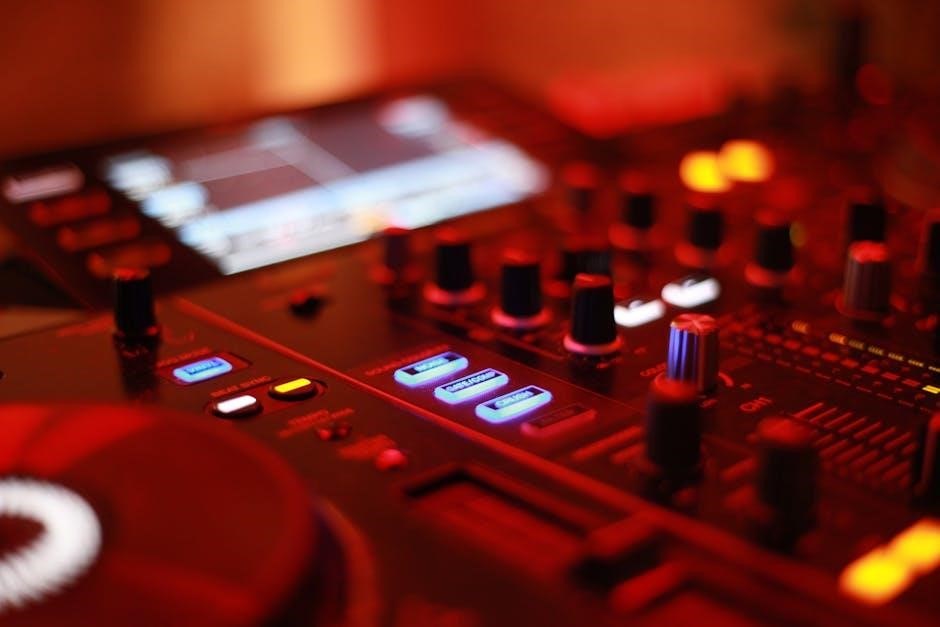Techno guides are comprehensive resources designed to help producers navigate the evolving landscape of techno music production, offering insights into tools, techniques, and emerging trends in the genre․
What is a Techno Guide?
A techno guide is a detailed resource that provides insights, tutorials, and best practices for creating and producing techno music․ It covers topics like setting up a studio, using DAWs, and mastering hardware synthesizers․ These guides often explore the integration of AI in music production, offering tips on generative AI for melody creation and AI-powered mixing tools․ They also delve into essential techniques, from basic beat creation to advanced layering and sidechaining․ Whether for beginners or seasoned producers, a techno guide serves as a comprehensive roadmap to enhance creativity and technical skills in the dynamic world of techno music production․
Why Techno Guides are Essential in the Digital Age
Techno guides are indispensable in today’s fast-paced digital landscape, offering producers a clear path to mastering the complex tools and techniques required for high-quality music production․ With the constant evolution of software, hardware, and AI-driven technologies, these resources provide up-to-date insights and practical advice․ They not only simplify the learning curve for novices but also empower experienced artists to explore innovative sounds and workflows․ By bridging the gap between creativity and technical proficiency, techno guides ensure producers stay competitive and adaptable in an ever-changing industry․

Essential Tools for Techno Music Production
Techno music production relies on a core set of tools, including DAWs, synthesizers, drum machines, and effects processors, to create and shape distinctive sounds and rhythms effectively․
DAWs (Digital Audio Workstations)
DAWs are the backbone of modern music production, offering a comprehensive platform for recording, editing, and mixing audio․ Popular DAWs like Ableton Live and FL Studio provide robust tools for techno producers, enabling precise control over beats, synths, and effects․ These applications often feature MIDI sequencing, sampling, and automation capabilities, which are essential for crafting intricate techno tracks․ With built-in effects and plugins, DAWs allow artists to shape their sound with ease․ They also support collaboration and project organization, making them indispensable for both professionals and beginners in the techno music scene․
Hardware Synthesizers and Drum Machines
Hardware synthesizers and drum machines are cornerstone tools in techno production, offering tactile control and unique sonic textures․ Classics like the Roland TB-303 and TR-909 are revered for their distinctive sounds and durability․ These devices provide hands-on creativity, enabling producers to craft intricate patterns and evolving sequences․ Unlike software, hardware often delivers a raw, organic quality that defines techno’s identity․ Drum machines, in particular, are essential for creating the genre’s signature rhythmic backbone․ Their physical interfaces allow for real-time experimentation, making them indispensable for both studio and live performances, ensuring a dynamic and authentic sound in techno music production․
Software Plugins for Sound Design
Software plugins are indispensable for shaping the sonic identity of techno tracks, offering vast creative possibilities․ From emulating vintage hardware to generating futuristic textures, these tools provide precision and flexibility․ Plugins like FM synths and granular processors enable producers to craft unique, otherworldly sounds․ They often include advanced modulation systems, allowing for dynamic, evolving timbres․ With intuitive interfaces and real-time editing, plugins streamline the sound design process․ Whether creating deep basslines or intricate atmospheres, software plugins empower producers to push boundaries, making them essential for modern techno production and experimentation in the digital studio environment․
The Role of AI in Modern Techno Production
AI revolutionizes techno production by enhancing creativity and efficiency, offering generative tools, intelligent mixing, and adaptive workflows that inspire innovation and streamline complex processes for producers․
Generative AI for Music Creation
Generative AI empowers producers to craft unique melodies, beats, and loops by generating musical patterns and ideas․ Tools like AI-powered DAWs and plugins enable the creation of intricate techno tracks, fostering creativity․ These systems analyze existing music to produce original content, aiding artists in exploring new sounds․ For instance, AI can suggest drum patterns or synth lines, accelerating the production process․ This technology not only enhances efficiency but also inspires innovation, allowing producers to experiment with unconventional techniques and push the boundaries of techno music․ It serves as both a creative partner and a time-saving tool, revolutionizing modern production workflows․
AI-Powered Mixing and Mastering Tools
AI-powered mixing and mastering tools are revolutionizing how techno producers finalize their tracks․ These tools analyze audio elements and apply precise adjustments, ensuring balanced frequencies and optimal loudness․ By learning from professional mixes, AI can automatically enhance dynamics, EQ, and compression, achieving polished results․ This technology saves time while maintaining high-quality output, allowing artists to focus on creativity․ Advanced algorithms even adapt to specific genres, making them ideal for techno’s unique demands․ As a result, AI is becoming an indispensable asset for achieving professional-grade mixes and masters efficiently and effectively․
Techno Guide for Beginners
A techno guide for beginners provides a foundational roadmap, introducing essential tools, techniques, and workflows to kickstart your music production journey effectively and creatively․
Setting Up Your First Studio
Setting up your first studio is an exciting step in your techno music journey․ Start with the basics: a computer, DAW, MIDI controller, and reliable audio interface․ Choose a quiet, acoustically treated space to minimize echo and interference․ Invest in quality studio monitors and headphones for accurate sound reproduction․ Organize your cables and equipment neatly to ensure efficiency․ Finally, familiarize yourself with your DAW’s interface and essential plugins․ A well-structured studio setup will streamline your workflow and enhance your creativity as you begin producing techno music․
Basic Techniques for Creating Techno Beats
Creating techno beats starts with a solid drum pattern, often built around a four-on-the-floor kick drum․ Add snappy snares and hi-hats to establish rhythm and groove․ Experiment with shakers or claps for added texture; Layer a deep, driving bassline that complements the drums, ensuring it’s minimal yet impactful․ Introduce melodic elements like synth stabs or arpeggiators to add depth․ Use repetition and subtle variations to build tension․ finally, arrange your elements into a cohesive structure, starting with an intro, building to a climax, and resolving with an outro․ Automation and effects will enhance the dynamic feel of your beats․

Advanced Techniques in Techno Production
Explore sophisticated methods to refine your sound, from intricate layering to dynamic automation, enhancing depth and complexity in your techno tracks for a professional finish․
Using Sidechaining for Dynamic Control
Sidechaining is a powerful technique used to dynamically control audio elements, creating space and balance in your mix․ It allows one track to influence the behavior of another, such as ducking vocals or basslines under a dominant kick drum․ By routing a source signal to a compressor or other effects, you can automate levels, enhance grooves, and add depth to your techno tracks․ This method is essential for achieving the tight, cohesive sound characteristic of modern techno production, ensuring harmonious interaction between rhythmic and melodic elements․
Creating Complex Rhythms and Layering
Creating complex rhythms and layering is a cornerstone of techno production, adding depth and intrigue to tracks․ By combining multiple drum patterns, percussion elements, and textures, producers craft intricate grooves that captivate listeners․ Layering involves blending sounds at different frequencies and dynamics to create a rich, immersive soundscape․ Techniques like polyrhythms, off-grid patterns, and strategic use of effects enhance rhythmic complexity․ This approach allows artists to experiment with unique sonic arrangements, pushing the boundaries of techno music and ensuring their work stands out in a competitive landscape․

Marketing Your Techno Music
Effective marketing strategies for techno music involve building a strong online presence, leveraging social media, and utilizing platforms to reach global audiences and grow your fanbase․
Building an Online Presence
Building a strong online presence is crucial for techno artists to connect with global audiences․ Start by creating a professional website showcasing your music, bio, and upcoming events․ Use SEO techniques to ensure your site is easily discoverable․ Consistent branding across social media platforms like Instagram, Facebook, and Twitter helps maintain a cohesive identity․ Share high-quality content, such as behind-the-scenes studio sessions or live performances, to engage fans․ Additionally, leverage music streaming platforms like SoundCloud, Spotify, and YouTube to distribute your tracks and reach a broader audience․ Regular updates and interactive posts can foster a loyal fanbase and keep your audience engaged․
Using Social Media for Promotion
Effective social media promotion is vital for techno artists to expand their reach․ Focus on platforms like Instagram, TikTok, and Twitter to share engaging content such as live performance clips, behind-the-scenes studio sessions, and exclusive previews․ Use hashtags to increase visibility and connect with techno enthusiasts․ Collaborate with influencers or fellow artists to tap into new audiences․ Regularly post updates and interact with followers to build a loyal community․ Utilize paid ads to target specific demographics and amplify your presence․ Consistent branding and high-quality visuals will enhance your appeal and attract more listeners to your music․

The Future of Techno Music
The future of techno music lies in immersive technologies like VR/AR performances and sustainable production practices, blending innovation with eco-conscious creativity for a dynamic, forward-thinking genre․
Emerging Trends in Techno
The techno scene is rapidly evolving, with AI-driven production tools and generative music algorithms reshaping sound design and beat creation․ Artists are leveraging AI to explore unconventional textures and rhythms, while immersive technologies like VR and AR are redefining live performances․ Sustainability is also becoming a focal point, as producers adopt eco-friendly practices and energy-efficient gear․ These trends highlight techno’s adaptability, blending innovation with artistic expression․ The genre continues to push boundaries, integrating cutting-edge technology and environmental consciousness to forge a forward-thinking musical landscape․
Techno and AI: The Next Generation
Techno music is entering a new era with AI as its catalyst․ Generative AI algorithms are enabling producers to craft unprecedented sounds and beats, while machine learning models analyze decades of techno tracks to predict future trends․ AI-powered tools are also revolutionizing live performances, allowing artists to adapt their sets in real time based on audience reactions․ This synergy between human creativity and artificial intelligence is redefining the boundaries of the genre, making it more dynamic and accessible than ever․ As AI continues to evolve, techno music is poised to embrace a future where innovation knows no limits․
The ever-evolving world of techno music demands continuous learning and adaptation․ By embracing new tools, techniques, and trends, producers can stay ahead in this dynamic and innovative field․
Staying Updated in the Techno World
Staying updated in the techno world requires constant engagement with the latest trends, tools, and techniques․ Follow blogs, forums, and social media dedicated to techno music production․ Explore emerging trends like AI-powered tools and innovative hardware․ Attend workshops and webinars to enhance your skills․ Join online communities to network with fellow producers and gain insights․ Regularly update your software and hardware to maintain compatibility and performance․ Stay curious and experiment with new sounds to keep your productions fresh and forward-thinking in this fast-paced genre․
Experimentation and Innovation
Experimentation and innovation are the lifeblood of techno music, driving creativity and pushing boundaries․ Producers often blend unconventional sounds and techniques to craft unique tracks․ Utilizing generative AI and advanced software plugins can inspire new ideas․ Embrace error as a stepping stone to discovery, allowing accidental sounds to shape your work․ Stay open to incorporating diverse influences, from ambient textures to industrial beats․ By continuously exploring and innovating, you keep your music fresh and contribute to the evolution of the techno genre, ensuring it remains dynamic and forward-thinking․